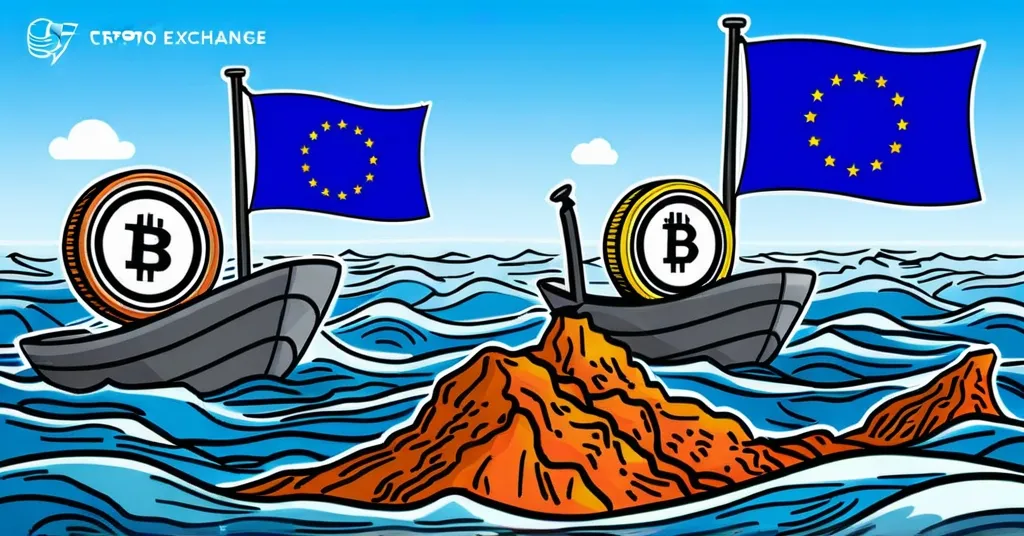Kraken and Crypto.com to Launch Proprietary Stablecoins in Response to EU’s MiCA Regulations

Kraken and Crypto.com Set to Launch Proprietary Stablecoins Amid EU Regulatory Changes
In a bold move to navigate the regulatory waves of the European Union, cryptocurrency giants Kraken and Crypto.com are preparing to launch their own proprietary stablecoins by 2025, prompted by the stringent requirements of the Markets in Crypto-Assets (MiCA) regulations.
- Kraken and Crypto.com plan to launch proprietary stablecoins.
- EU’s MiCA regulations prompt this strategic pivot.
- Broad implications for regulatory compliance and market stability.
Kraken’s Stablecoin Initiative
Kraken, renowned for its robust trading platform, is set to introduce a dollar-backed stablecoin through its Irish subsidiary. This initiative is a direct response to the European Union’s MiCA regulations, which came into effect in January 2025. MiCA requires all stablecoin issuers to secure EU authorization, pushing Kraken to take this proactive step. “Kraken intends to launch a dollar-backed proprietary stablecoin through its Irish subsidiary to maintain uninterrupted services in the EU under MiCA regulations,” a Kraken spokesperson confirmed. A stablecoin, for those new to the term, is a type of cryptocurrency designed to maintain a stable value, often pegged to a fiat currency like the US dollar. More details on Kraken’s plans can be found here.
Crypto.com’s Strategic Move
Similarly, Crypto.com is gearing up to debut its own proprietary stablecoin later in 2025. While the specifics of its fiat backing are yet to be revealed, Crypto.com has already expanded its services across the European Economic Area (EEA) after securing a MiCA license from Malta. “Crypto.com is in the process of developing its proprietary stablecoin, which is expected to debut later in 2025,” a representative from Crypto.com stated confidently. This move not only ensures compliance but also positions Crypto.com as a leader in the regulated crypto space within the EEA.
Regulatory Context: MiCA and ESMA
The MiCA regulations, officially known as the Markets in Crypto-Assets regulations, aim to create a harmonized regulatory framework for crypto assets across the EU, focusing on investor protection and market integrity. The European Securities and Markets Authority (ESMA) has been clear in its stance on non-compliant stablecoins, mandating their removal from trading platforms by the end of the first quarter of 2025. “The European Securities and Markets Authority (ESMA) has mandated that all non-compliant stablecoins be removed from trading platforms by the end of Q1 2025,” an ESMA official declared. This directive has forced exchanges to rethink their reliance on third-party stablecoins, which often lack the necessary EU authorization. For more on ESMA’s deadlines, see this announcement.
Industry Response
The regulatory shift is not limited to Kraken and Crypto.com. Other exchanges, like KuCoin, are also adapting by applying for MiCA licenses in countries such as Austria. This broader industry trend towards developing proprietary stablecoins reflects a move towards greater regulatory compliance and operational stability. It’s a clear signal that the crypto industry is not just about disruption but also about building a sustainable and trustworthy financial ecosystem. Discussions on these developments can be found on Reddit.
Implications and Challenges
The decision to launch proprietary stablecoins is a testament to the crypto industry’s resilience and adaptability. While some might see this as a departure from the libertarian ethos of the crypto world, it’s more about ensuring the longevity and legitimacy of these platforms in a regulated environment. After all, in the world of crypto, staying compliant might just be the new way to stay disruptive. Who knew that following the rules could be so rebellious?
However, this strategic pivot isn’t without its challenges. Exchanges must navigate the complex requirements of MiCA, secure the necessary EU authorization, and build trust in their new stablecoins amidst a regulatory crackdown on non-compliant assets. It’s a high-stakes game, but one that could pay off by boosting market confidence and paving the way for sustainable growth. For more on how MiCA impacts market stability, read this analysis.
Future Outlook
As Kraken and Crypto.com chart their course through the regulatory storm, they’re not just ensuring compliance; they’re paving the way for a new era of crypto stability and innovation. The move towards proprietary stablecoins could set a precedent for other exchanges, potentially leading to a more regulated and stable crypto market in the EU. It’s a bold step that could encourage further innovation in stablecoin technology to meet the evolving regulatory standards. More on the EU’s crypto regulations and exchange compliance can be found here.
Imagine if the crypto world could balance the wild west spirit of decentralization with the stability and trust of regulatory compliance. What if the future of finance lies in this delicate equilibrium?
Key Questions and Takeaways
What prompted Kraken and Crypto.com to plan their own stablecoins?
The EU’s MiCA regulations, requiring stablecoin issuers to obtain EU authorization, prompted these exchanges to develop proprietary stablecoins to ensure compliance and operational stability within the EU market.
What is the significance of the MiCA regulations for the crypto industry?
MiCA aims to standardize crypto asset regulation in the EU, focusing on investor protection and market integrity, pushing the industry towards greater compliance and transparency.
How are other exchanges responding to these regulations?
Other exchanges, like KuCoin, are also taking steps to comply with MiCA by applying for licenses in EU countries, indicating a broader industry shift towards regulatory alignment.
What are the potential benefits of exchanges launching their own stablecoins?
Launching proprietary stablecoins can ensure uninterrupted service in the EU, reduce reliance on potentially non-compliant third-party issuers, and enhance operational stability and market confidence.
What challenges might exchanges face in developing their own stablecoins?
Challenges include ensuring compliance with MiCA’s detailed requirements, securing EU authorization, and maintaining trust in their stablecoins amidst regulatory scrutiny.



